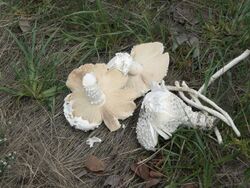Biology:Termitomyces schimperi
| Termitomyces schimperi | |
|---|---|

| |
| Scientific classification | |
| Domain: | Eukaryota |
| Kingdom: | Fungi |
| Division: | Basidiomycota |
| Class: | Agaricomycetes |
| Order: | Agaricales |
| Family: | Lyophyllaceae |
| Genus: | Termitomyces |
| Species: | T. schimperi
|
| Binomial name | |
| Termitomyces schimperi (Pat.) R.Heim (1942)
| |
| Synonyms[1] | |
| |
Termitomyces schimperi is a large mushroom associated with the termite species Macrotermes michaelseni. It grows in the northern part of Southern Africa, from northern Namibia up to Democratic Republic of Congo (DRC), eastwards to Malawi and Mozambique, and westwards to Ivory Coast.[2][3][4]
In Namibia it is commonly referred to by its Herero name Ejova (singular)/ Omajowa (plural). German Namibians refer to the mushroom as "Termitenpilz."[5]
Characteristics
Termitomyces schimperi can grow to the size of a "large frying pan".[2] When they emerge, the fruitbody of the fungus are the "size of a man’s fist", before rapidly expanding to 15–28 cm and sometimes reaching 40 cm in diameter.[5] The tops are white. Yellowish to red-brown discolouration of the thick soft scales may occur by the mound soil.[5] Below the top most layer, the scales are white.[5] The pseudorhiza (a cord-like structure resembling a plant root) is narrower at its origin in the termite nest, and may be as long as 90 cm. Its consistency above ground is less dense. The sporocarps can be seen in groups of 5–10 around the lower parts of termite mound, and grow to around 50 cm above soil level. Up to 50 sporocarps have been reported around a single mound. The Termitomyces schimperi usually appear after soaking rains of 12 mm or more during spring, but the main crop develops during January to March which is the main rainy season. If the hyphae remain in the mound when harvested, they may grow on the same termite mound for many years. The termites consume the partial veil following maturation of the fungus.[5]
Termite association
Termitomyces schimperi do not appear on all termite mounds.[5] They grow on tall termite mounds of central and northern parts of Namibia where a large rainfall occurs, and can often extend to 4-5 m in height. Their tops inclinetowards the north. The associated termite is the Termes bellicosus also known as Macrotermes michaelseni. In Zambia the Termitomyces schimperi is found at the termite mounds of Odontotermes patruus.[5]
Cultural association
The mushroom is seen as a symbol of growth and prosperity by Namibians and is highly valued in Namibian culture.[6] Their popularity in Africa is reflected in their appearance on postage stamps.[7] It has high value as an edible source in the Ivory Coast.[4]
References
- ↑ "GSD Species Synonymy: Termitomyces schimperi (Pat.) R. Heim". Species Fungorum. CAB International. http://www.speciesfungorum.org/GSD/GSDspecies.asp?RecordID=291356.
- ↑ 2.0 2.1 (in en) Conservation and the Environment in Namibia. Venture Publications in collaboration with the Ministry of Environment and Tourism. 2006. p. 49. https://books.google.com/books?id=PIEfAQAAIAAJ.
- ↑ Wild edible fungi a global overview of their use and importance to people, Annex 2: Country records of wild useful fungi (edible, medicinal and other uses), United Nations: Agriculture and Consumer Protection, Food and Agriculture Organization of the United Nations, http://www.fao.org/docrep/007/y5489e/y5489e13.htm, retrieved 18 February 2016
- ↑ 4.0 4.1 Koné, N’golo Abdoulaye; Soro, Bakary; Vanié-Léabo, Linda Patricia Louyounan; Konaté, Souleymane; Bakayoko, Adama; Koné, Daouda (2018-07-30). "Diversity, phenology and distribution of Termitomyces species in Côte d'Ivoire". Mycology 9 (4): 307–315. doi:10.1080/21501203.2018.1500498. ISSN 2150-1203. PMID 30533255.
- ↑ 5.0 5.1 5.2 5.3 5.4 5.5 5.6 van der Westhuizen, G.C.A.; Eicker, A. (February 1991). "The 'Omajowa' or 'Termitenpilz', Termitomyces sp. (Agaricales) of Namibia". South African Journal of Botany 57 (1): 67–70. doi:10.1016/S0254-6299(16)30986-3. https://webcache.googleusercontent.com/search?q=cache:dvbrBYQHuqAJ:https://cyberleninka.org/article/n/1441631.pdf+&cd=1&hl=en&ct=clnk&gl=uk&client=safari.
- ↑ Ozondjahe Hunting Safaris. "Omajowa, Termite Hill Mushrooms in Namibia". Ozondjahe Hunting Safaris. http://www.africahunting.com/content/2-omajowa-termite-hill-mushrooms-namibia-607/.
- ↑ Chang, S. T.; Chang, Shu-ting; Quimio, T. H. (1982) (in en). Tropical Mushrooms: Biological Nature and Cultivation Methods. Hong Kong: The Chinese University Press. pp. 448–449. ISBN 962-201-264-7. https://books.google.com/books?id=0luzyrBPARgC&pg=PA448.
Wikidata ☰ Q10693387 entry
 |


